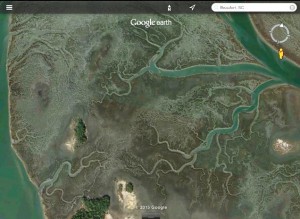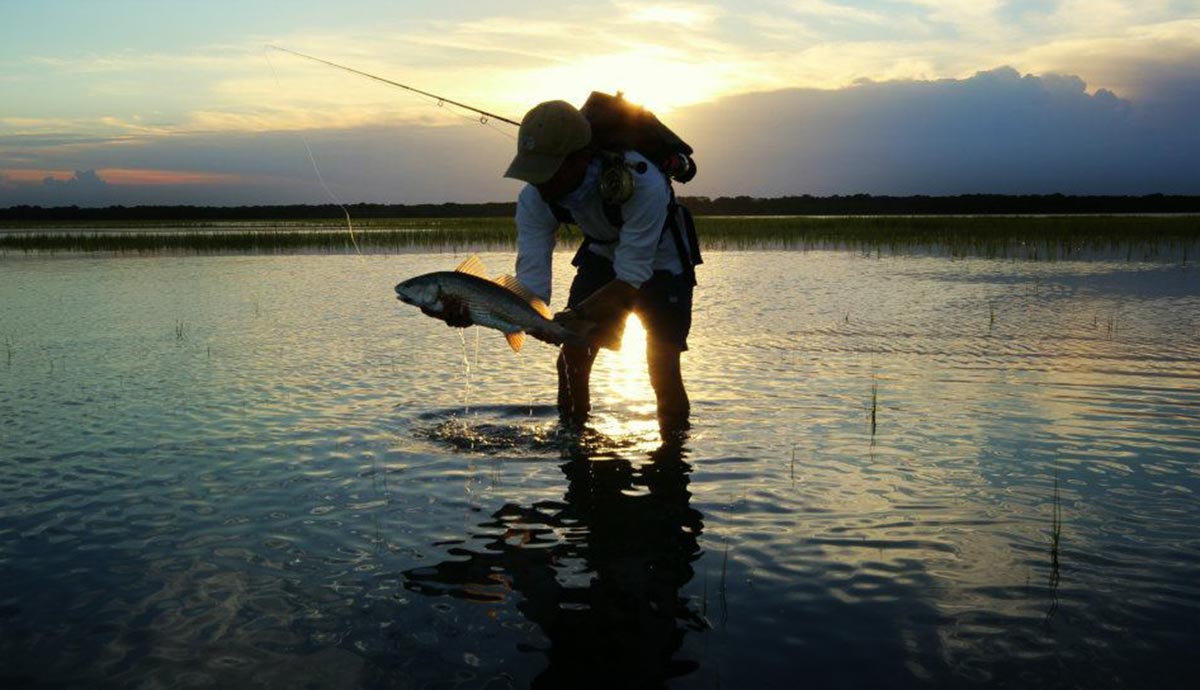By Owen Plair
Now that you all have a good grasp on how this flood tide fishing works, it’s time to put it all to use!
In this article we are going to focus on finding the right flood tide flat and the characteristics that make it a good flat. The great thing about the Lowcountry is that there are hundreds and hundreds of these flats all the way from north Florida up to North Carolina, so finding one near where you live should be pretty darn easy. Keep in mind many of these flats are found by kayak, or simply from a car, so it’s not like you have to own a boat to hit the spartina flats for tailers.
The absolute number one tool I use to find high tide redfish flats is Google Earth. Google Earth is a godsend to fly anglers. It allows us to not only look at new bodies of water from our living room couch but creates a different perspective on any given flat, by looking from a bird’s eye view. The key to using Google Earth is knowing what short grass looks like from an aerial view, so that you can identify more good flats. Before you can do any of that you need to find a flat and learn some characteristics that will help you find even more on Google Earth.
 Another necessary tool is a tide chart, tide log, or tide app. Without one of these you are just wasting your time. You have to have the right set of tides to even fish for flood tide fish, so your first mission is to figure out the best tides for your area. Here in Beaufort/Hilton Head I like a tide between 7.8ft-8.5ft for solid flood tide fishing. A good east wind will bring in more water and a good west wind will hold water out, so also keep your wind direction in mind while you’re scouting.
Another necessary tool is a tide chart, tide log, or tide app. Without one of these you are just wasting your time. You have to have the right set of tides to even fish for flood tide fish, so your first mission is to figure out the best tides for your area. Here in Beaufort/Hilton Head I like a tide between 7.8ft-8.5ft for solid flood tide fishing. A good east wind will bring in more water and a good west wind will hold water out, so also keep your wind direction in mind while you’re scouting.
Wading boots or a poling skiff are key to scouting a flat because you want to be able to cover everything around you. I like to walk new flats before the tide gets high to make sure there is a good population of fiddler crabs. It also helps you know areas you can, or can’t wade during the tide.
When looking for a flood tide flat you want to look for short spartina grass.
Tailing flats have shorter grass, 8-16 inches tall. The grass is short because it only gets water during those bigger tides. The great thing about short grass flats is that the bottom is hard, not soft mud like flats with taller grass. Never try to walk or wade in grass taller than 2-3ft because you run the risk of sinking in the pluff mud!
You can find most of these flats close to small barrier islands, along the outside of the larger islands, or in the middle of larger areas of tall spartina grass. Look for areas of higher elevation, that do not get water unless there’s a flood tide. Some flats will need smaller tides to flood and other flats will need larger tides. Keep this in mind, because not all flats will fish on the same tides.
Once you find a good size flat, between 100-300 square yards, its time to figure out where the fish start to move in first.
Feeder creeks are the main entry point for redfish onto a mud flat. These small creeks are like a highway for redfish as the tide floods the flat and they’re always the first areas fish will start to work. It’s one of my favorite things for new anglers to experience. You have a dry section of flat and within minutes the water comes up, and so do the tails.
Walking a flat as the tide pushes in will help you find the areas where fish feed first. When you start to see fish, remember exactly what stage the tide is at. Next time you will know exactly where to be when that flat floods.
Working the edges of the taller grass during the incoming flood tide is also key, because redfish are constantly filtering onto the flat during the incoming tide. Working slowly along the edge of the taller grass, looking for signs of fish moving onto the flat will help you to learn other areas to fish.
When the flat starts to flood, it’s time to start the hunt.
Looking for tails throughout the whole flat and learning where you see the most fish. Find a flat close to where you know there is a good population of redfish. Then you know there are fish that will come onto that flat. I cannot tell you how many flats I have scouted that hold tons of crabs, have perfect grass, but no fish. This happens often and that’s how you learn a good flat from a bad flat.
Redfish are homey and like to feed in the same areas so once you find a good flat, you have another notch in your redfish belt. You don’t want to fish the same flat every time you go because over time the pressure will affect your fishing. That is why scouting and finding new flats is so important.
Doing your homework will pay off big. You have the information, now get out and catch yourself some flood tide redfish!
Learn More!
Flood Tide Redfish Part 1
Flood Tide Redfish Part 2
Owen Plair Gink & Gasoline www.ginkandgasoline.com hookups@ginkandgasoline.com Sign Up For Our Weekly Newsletter!



Well done. A very informative article. The method is useful for finding many species with only slight modifications to methodology.
Great article! Wish I had this information back in December when I went saltwater fly fishing for redfish on Hilton Head – my first attempt at redfish and saltwater. I had some success but it took a week+ of fishing hard on the flats. The only time I caught fish was about an hour before high tide and I had to cast about 70′ (super challenging for a rookie like me) to reach them. Can’t wait to get back in the salt.
Tim,
Going to HHI in a few weeks. What flats do you fish at?
Thanks!
This is an excellent series of articles. I just got around to reading them all and agree with all of your points. Great work on this!
Matt
All of the above is a great start and spot on. One tidbit: I got to the point to where I can gauge the point of the tide to expect tails based upon depth of water on my leg when wading. For me, midcalf is about peak. Once you get close to the knee, you have to look for much more subtle signs to sight fish. You can get to the point where you can time the tide at a particular location and expect to be able to see tails- say from point A to point B on your leg, otherwise it’s time to either wait (too shallow), or to move (too deep), and they are pushing up the flat. I also really like to look for flood tides not too far (maybe 1 hr) from dusk in my area in the Summer as the p.m. thunderstorms tend to fizzle out, and the wind starts to lay down.